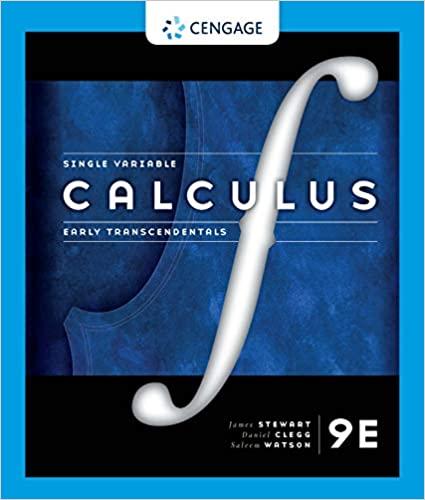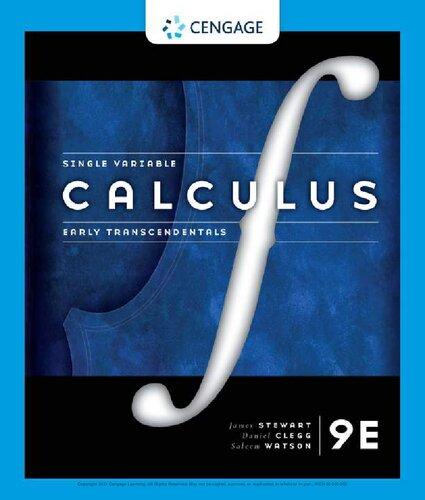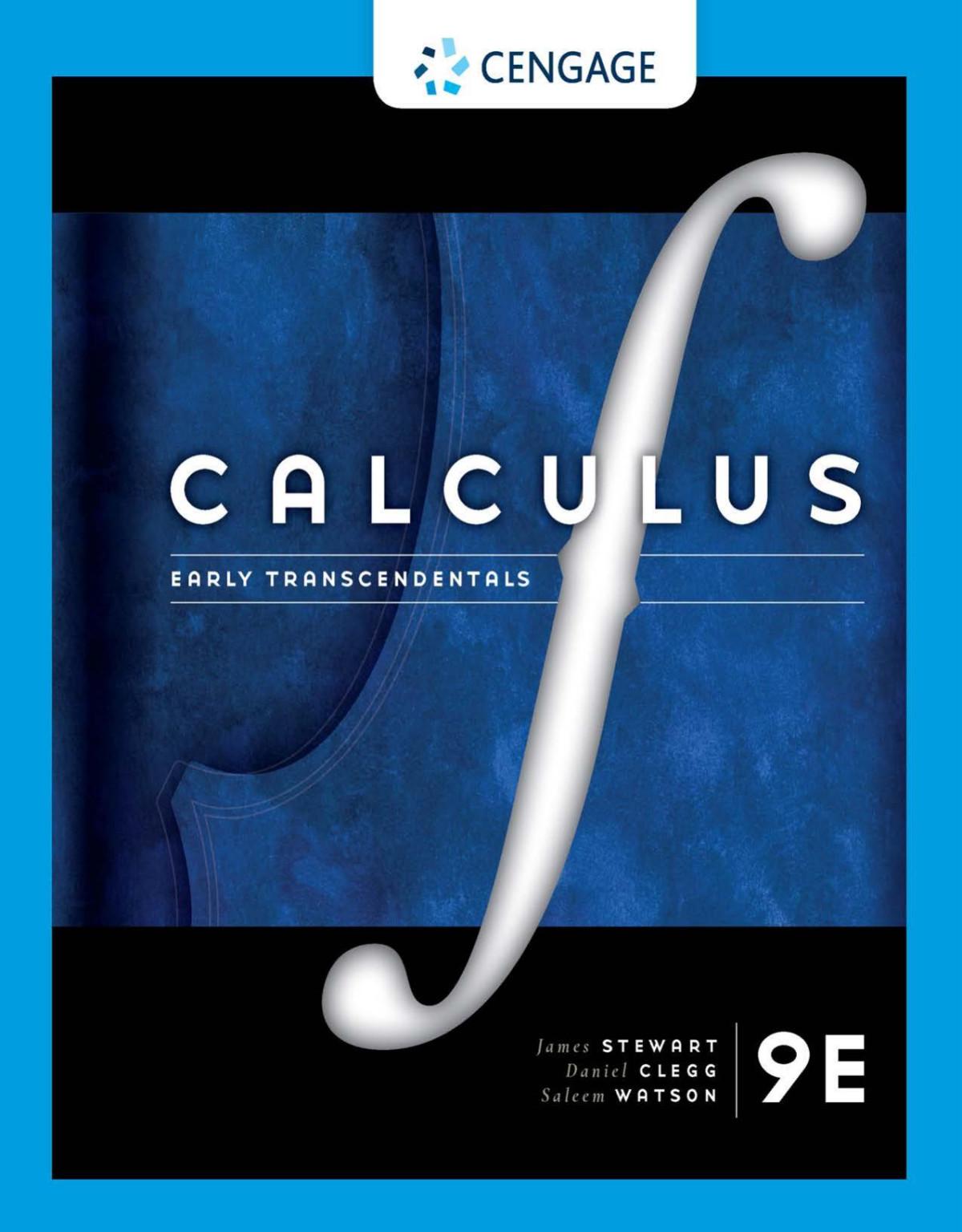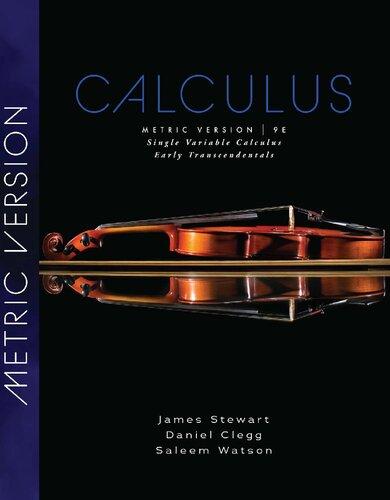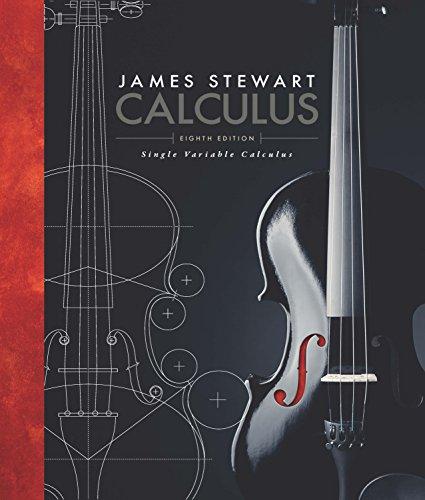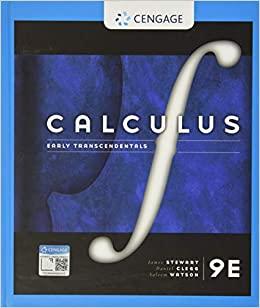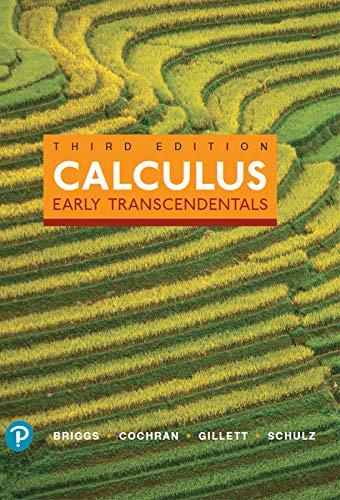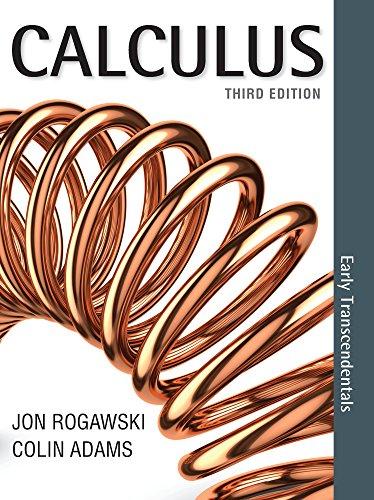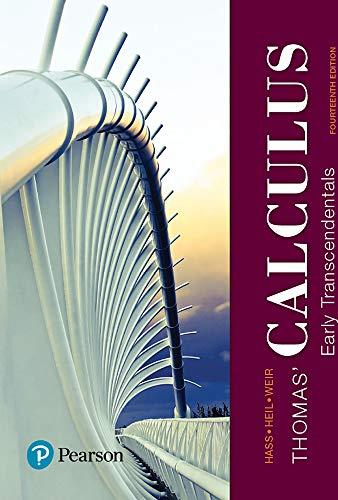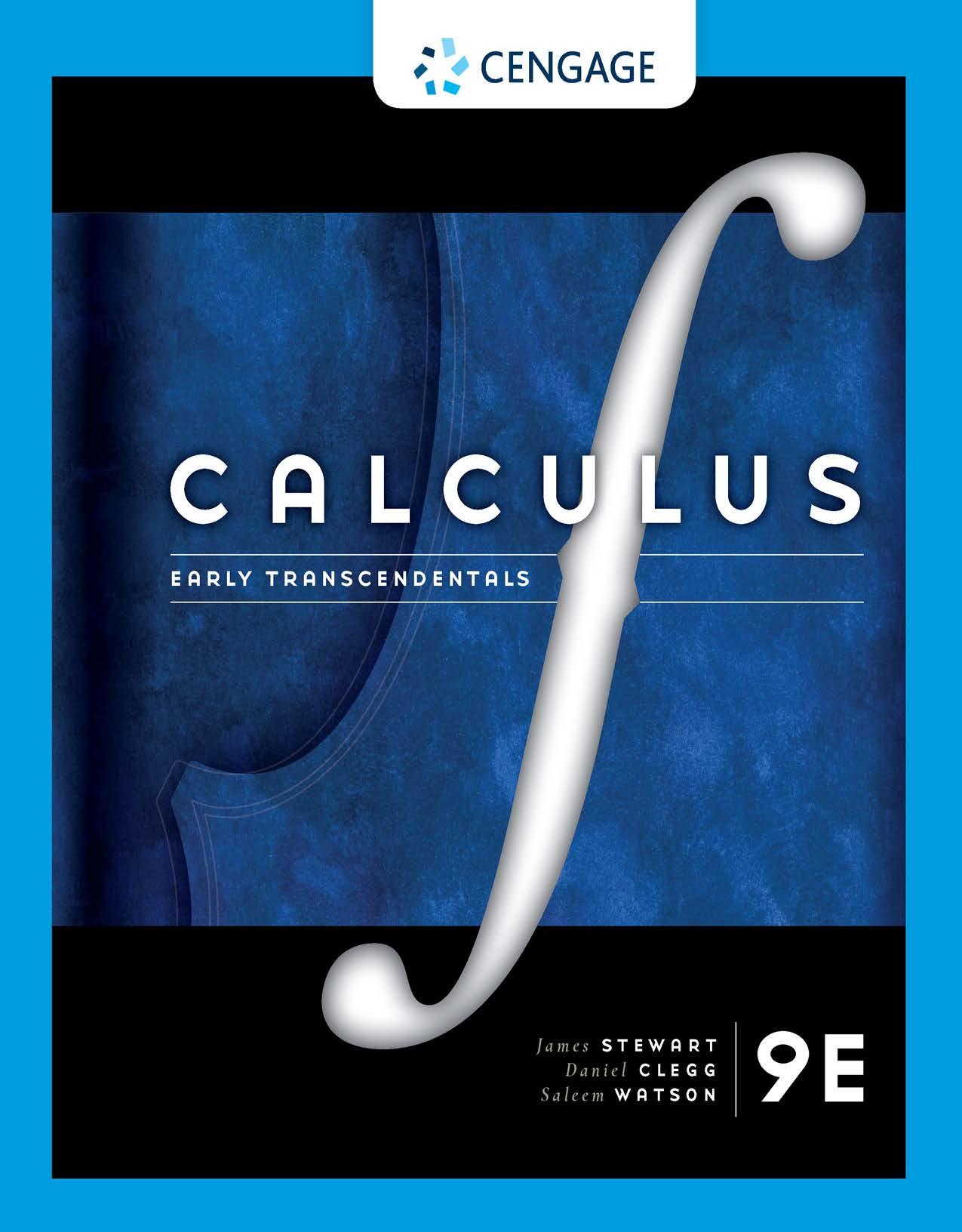Preface
A great discovery solves a great problem but there is a grain of discovery in the solution of any problem. Your problem may be modest; but if it challenges your curiosity and brings into play your inventive faculties, and if you solve it by your own means, you may experience the tension and enjoy the triumph of discovery.
george polya
The art of teaching, Mark Van Doren said, is the art of assisting discovery. In this Ninth Edition, as in all of the preceding editions, we continue the tradition of writing a book that, we hope, assists students in discovering calculus both for its practical power and its surprising beauty. We aim to convey to the student a sense of the utility of calculus as well as to promote development of technical ability. At the same time, we strive to give some appreciation for the intrinsic beauty of the subject. Newton undoubtedly experienced a sense of triumph when he made his great discoveries. We want students to share some of that excitement.
The emphasis is on understanding concepts. Nearly all calculus instructors agree that conceptual understanding should be the ultimate goal of calculus instruction; to implement this goal we present fundamental topics graphically, numerically, algebraically, and verbally, with an emphasis on the relationships between these different representations. Visualization, numerical and graphical experimentation, and verbal descriptions can greatly facilitate conceptual understanding. Moreover, conceptual understanding and technical skill can go hand in hand, each reinforcing the other.
We are keenly aware that good teaching comes in different forms and that there are different approaches to teaching and learning calculus, so the exposition and exercises are designed to accommodate different teaching and learning styles. The features (including projects, extended exercises, principles of problem solving, and historical insights) provide a variety of enhancements to a central core of fundamental concepts and skills. Our aim is to provide instructors and their students with the tools they need to chart their own paths to discovering calculus.
Alternate Versions
The Stewart Calculus series includes several other calculus textbooks that might be preferable for some instructors. Most of them also come in single variable and multivariable versions.
• Calculus, Ninth Edition, is similar to the present textbook except that the exponential, logarithmic, and inverse trigonometric functions are covered after the chapter on integration.
• Essential Calculus, Second Edition, is a much briefer book (840 pages), though it contains almost all of the topics in Calculus, Ninth Edition. The relative brevity is achieved through briefer exposition of some topics and putting some features on the website.
• Essential Calculus: Early Transcendentals, Second Edition, resembles Essential Calculus, but the exponential, logarithmic, and inverse trigonometric functions are covered in Chapter 3.
• Calculus: Concepts and Contexts, Fourth Edition, emphasizes conceptual understanding even more strongly than this book. The coverage of topics is not encyclopedic and the material on transcendental functions and on parametric equations is woven throughout the book instead of being treated in separate chapters.
• Brief Applied Calculus is intended for students in business, the social sciences, and the life sciences.
• Biocalculus: Calculus for the Life Sciences is intended to show students in the life sciences how calculus relates to biology.
• Biocalculus: Calculus, Probability, and Statistics for the Life Sciences contains all the content of Biocalculus: Calculus for the Life Sciences as well as three additional chapters covering probability and statistics.
What’s New in the Ninth Edition?
The overall structure of the text remains largely the same, but we have made many improvements that are intended to make the Ninth Edition even more usable as a teaching tool for instructors and as a learning tool for students. The changes are a result of conversations with our colleagues and students, suggestions from users and reviewers, insights gained from our own experiences teaching from the book, and from the copious notes that James Stewart entrusted to us about changes that he wanted us to consider for the new edition. In all the changes, both small and large, we have retained the features and tone that have contributed to the success of this book.
• More than 20% of the exercises are new:
Basic exercises have been added, where appropriate, near the beginning of exercise sets. These exercises are intended to build student confidence and reinforce understanding of the fundamental concepts of a section. (See, for instance, Exercises 7.3.1 – 4, 9.1.1 – 5, 11.4.3 – 6.)
Some new exercises include graphs intended to encourage students to understand how a graph facilitates the solution of a problem; these exercises complement subsequent exercises in which students need to supply their own graph. (See Exercises 6.2.1– 4, Exercises 10.4.43 – 46 as well as 53 – 54, 15.5.1 – 2, 15.6.9 – 12, 16.7.15 and 24, 16.8.9 and 13.)
Some exercises have been structured in two stages, where part (a) asks for the setup and part (b) is the evaluation. This allows students to check their answer to part (a) before completing the problem. (See Exercises 6.1.1 – 4, 6.3.3 – 4, 15.2.7 – 10.)
Some challenging and extended exercises have been added toward the end of selected exercise sets (such as Exercises 6.2.87, 9.3.56, 11.2.79 – 81, and 11.9.47).
Titles have been added to selected exercises when the exercise extends a concept discussed in the section. (See, for example, Exercises 2.6.66, 10.1.55 – 57, 15.2.80 – 81.)
Some of our favorite new exercises are 1.3.71, 3.4.99, 3.5.65, 4.5.55 – 58, 6.2.79, 6.5.18, 10.5.69, 15.1.38, and 15.4.3 – 4. In addition, Problem 14 in the Problems Plus following Chapter 6 and Problem 4 in the Problems Plus following Chapter 15 are interesting and challenging.
• New examples have been added, and additional steps have been added to the solutions of some existing examples. (See, for instance, Example 2.7.5, Example 6.3.5, Example 10.1.5, Examples 14.8.1 and 14.8.4, and Example 16.3.4.)
• Several sections have been restructured and new subheads added to focus the organization around key concepts. (Good illustrations of this are Sections 2.3, 11.1, 11.2, and 14.2.)
• Many new graphs and illustrations have been added, and existing ones updated, to provide additional graphical insights into key concepts.
• A few new topics have been added and others expanded (within a section or in extended exercises) that were requested by reviewers. (Examples include a subsection on torsion in Section 13.3, symmetric difference quotients in Exercise 2.7.60, and improper integrals of more than one type in Exercises 7.8.65 – 68.)
• New projects have been added and some existing projects have been updated. (For instance, see the Discovery Project following Section 12.2, The Shape of a Hanging Chain.)
• Derivatives of logarithmic functions and inverse trigonometric functions are now covered in one section (3.6) that emphasizes the concept of the derivative of an inverse function.
• Alternating series and absolute convergence are now covered in one section (11.5).
• The chapter on Second-Order Differential Equations, as well as the associated appendix section on complex numbers, has been moved to the website.
Features
Each feature is designed to complement different teaching and learning practices. Throughout the text there are historical insights, extended exercises, projects, problemsolving principles, and many opportunities to experiment with concepts by using technology. We are mindful that there is rarely enough time in a semester to utilize all of these features, but their availability in the book gives the instructor the option to assign some and perhaps simply draw attention to others in order to emphasize the rich ideas of calculus and its crucial importance in the real world.
n Conceptual Exercises
The most important way to foster conceptual understanding is through the problems that the instructor assigns. To that end we have included various types of problems. Some exercise sets begin with requests to explain the meanings of the basic concepts of the section (see, for instance, the first few exercises in Sections 2.2, 2.5, 11.2, 14.2, and 14.3) and most exercise sets contain exercises designed to reinforce basic understanding (such as Exercises 2.5.3 – 10, 5.5.1 – 8, 6.1.1 – 4, 7.3.1 – 4, 9.1.1 – 5, and 11.4.3 – 6). Other exercises test conceptual understanding through graphs or tables (see Exercises 2.7.17, 2.8.36 – 38, 2.8.47 – 52, 9.1.23 – 25, 10.1.30 – 33, 13.2.1 – 2, 13.3.37 – 43, 14.1.41 – 44, 14.3.2, 14.3.4 – 6, 14.6.1 – 2, 14.7.3 – 4, 15.1.6 – 8, 16.1.13 – 22, 16.2.19 – 20, and 16.3.1 – 2). Many exercises provide a graph to aid in visualization (see for instance Exercises 6.2.1 – 4, 10.4.43 – 46, 15.5.1 – 2, 15.6.9 – 12, and 16.7.24). Another type of exercise uses verbal descriptions to gauge conceptual understanding (see Exercises 2.5.12, 2.8.66, 4.3.79 – 80, and 7.8.79). In addition, all the review sections begin with a Concept Check and a True-False Quiz.
We particularly value problems that combine and compare graphical, numerical, and algebraic approaches (see Exercises 2.6.45 – 46, 3.7.29, and 9.4.4).
n Graded Exercise Sets
Each exercise set is carefully graded, progressing from basic conceptual exercises, to skill-development and graphical exercises, and then to more challenging exercises that often extend the concepts of the section, draw on concepts from previous sections, or involve applications or proofs.
n Real-World Data
Real-world data provide a tangible way to introduce, motivate, or illustrate the concepts of calculus. As a result, many of the examples and exercises deal with functions defined by such numerical data or graphs. These real-world data have been obtained by contacting companies and government agencies as well as researching on the Internet and in libraries. See, for instance, Figure 1 in Section 1.1 (seismograms from the Northridge earthquake), Exercise 2.8.36 (number of cosmetic surgeries), Exercise 5.1.12 (velocity of the space shuttle Endeavour), Exercise 5.4.83 (power consumption in the New England states), Example 3 in Section 14.4 (the heat index), Figure 1 in Section 14.6 (temperature contour map), Example 9 in Section 15.1 (snowfall in Colorado), and Figure 1 in Section 16.1 (velocity vector fields of wind in San Francisco Bay).
n Projects
One way of involving students and making them active learners is to have them work (perhaps in groups) on extended projects that give a feeling of substantial accomplishment when completed. There are three kinds of projects in the text.
Applied Projects involve applications that are designed to appeal to the imagination of students. The project after Section 9.5 asks whether a ball thrown upward takes longer to reach its maximum height or to fall back to its original height (the answer might surprise you). The project after Section 14.8 uses Lagrange multipliers to determine the masses of the three stages of a rocket so as to minimize the total mass while enabling the rocket to reach a desired velocity.
Discovery Projects anticipate results to be discussed later or encourage discovery through pattern recognition (see the project following Section 7.6, which explores patterns in integrals). Other discovery projects explore aspects of geometry: tetrahedra (after Section 12.4), hyperspheres (after Section 15.6), and intersections of three cylinders (after Section 15.7). Additionally, the project following Section 12.2 uses the geometric definition of the derivative to find a formula for the shape of a hanging chain. Some projects make substantial use of technology; the one following Section 10.2 shows how to use Bézier curves to design shapes that represent letters for a laser printer.
Writing Projects ask students to compare present-day methods with those of the founders of calculus Fermat’s method for finding tangents, for instance, following Section 2.7. Suggested references are supplied.
More projects can be found in the Instructor’s Guide. There are also extended exercises that can serve as smaller projects. (See Exercise 4.7.53 on the geometry of beehive cells, Exercise 6.2.87 on scaling solids of revolution, or Exercise 9.3.56 on the formation of sea ice.)
n Problem Solving
Students usually have difficulties with problems that have no single well-defined procedure for obtaining the answer. As a student of George Polya, James Stewart
experienced first-hand Polya’s delightful and penetrating insights into the process of problem solving. Accordingly, a modified version of Polya’s four-stage problemsolving strategy is presented following Chapter 1 in Principles of Problem Solving. These principles are applied, both explicitly and implicitly, throughout the book. Each of the other chapters is followed by a section called Problems Plus, which features examples of how to tackle challenging calculus problems. In selecting the Problems Plus problems we have kept in mind the following advice from David Hilbert: “A mathematical problem should be difficult in order to entice us, yet not inaccessible lest it mock our efforts.” We have used these problems to great effect in our own calculus classes; it is gratifying to see how students respond to a challenge. James Stewart said, “When I put these challenging problems on assignments and tests I grade them in a different way . . . I reward a student significantly for ideas toward a solution and for recognizing which problem-solving principles are relevant.”
n Technology
When using technology, it is particularly important to clearly understand the concepts that underlie the images on the screen or the results of a calculation. When properly used, graphing calculators and computers are powerful tools for discovering and understanding those concepts. This textbook can be used either with or without technology we use two special symbols to indicate clearly when a particular type of assistance from technology is required. The icon ; indicates an exercise that definitely requires the use of graphing software or a graphing calculator to aid in sketching a graph. (That is not to say that the technology can’t be used on the other exercises as well.) The symbol means that the assistance of software or a graphing calculator is needed beyond just graphing to complete the exercise. Freely available websites such as WolframAlpha.com or Symbolab.com are often suitable. In cases where the full resources of a computer algebra system, such as Maple or Mathematica, are needed, we state this in the exercise. Of course, technology doesn’t make pencil and paper obsolete. Hand calculation and sketches are often preferable to technology for illustrating and reinforcing some concepts. Both instructors and students need to develop the ability to decide where using technology is appropriate and where more insight is gained by working out an exercise by hand.
n WebAssign: webassign.net
This Ninth Edition is available with WebAssign, a fully customizable online solution for STEM disciplines from Cengage. WebAssign includes homework, an interactive mobile eBook, videos, tutorials and Explore It interactive learning modules. Instructors can decide what type of help students can access, and when, while working on assignments. The patented grading engine provides unparalleled answer evaluation, giving students instant feedback, and insightful analytics highlight exactly where students are struggling. For more information, visit cengage.com/WebAssign.
n Stewart Website
Visit StewartCalculus.com for these additional materials:
• Homework Hints
• Solutions to the Concept Checks (from the review section of each chapter)
• Algebra and Analytic Geometry Review
• Lies My Calculator and Computer Told Me
• History of Mathematics, with links to recommended historical websites
• Additional Topics (complete with exercise sets): Fourier Series, Rotation of Axes, Formulas for the Remainder Theorem in Taylor Series
• Additional chapter on second-order differential equations, including the method of series solutions, and an appendix section reviewing complex numbers and complex exponential functions
• Instructor Area that includes archived problems (drill exercises that appeared in previous editions, together with their solutions)
• Challenge Problems (some from the Problems Plus sections from prior editions)
• Links, for particular topics, to outside Web resources
Content
Diagnostic Tests
A Preview of Calculus
1 Functions and Models
2 Limits and Derivatives
The book begins with four diagnostic tests, in Basic Algebra, Analytic Geometry, Functions, and Trigonometry.
This is an overview of the subject and includes a list of questions to motivate the study of calculus.
From the beginning, multiple representations of functions are stressed: verbal, numerical, visual, and algebraic. A discussion of mathematical models leads to a review of the standard functions, including exponential and logarithmic functions, from these four points of view.
The material on limits is motivated by a prior discussion of the tangent and velocity problems. Limits are treated from descriptive, graphical, numerical, and algebraic points of view. Section 2.4, on the precise definition of a limit, is an optional section. Sections 2.7 and 2.8 deal with derivatives (including derivatives for functions defined graphically and numerically) before the differentiation rules are covered in Chapter 3. Here the examples and exercises explore the meaning of derivatives in various contexts. Higher derivatives are introduced in Section 2.8.
3 Differentiation Rules
4 Applications of Differentiation
All the basic functions, including exponential, logarithmic, and inverse trigonometric functions, are differentiated here. The latter two classes of functions are now covered in one section that focuses on the derivative of an inverse function. When derivatives are computed in applied situations, students are asked to explain their meanings. Exponential growth and decay are included in this chapter.
The basic facts concerning extreme values and shapes of curves are deduced from the Mean Value Theorem. Graphing with technology emphasizes the interaction between calculus and machines and the analysis of families of curves. Some substantial optimization problems are provided, including an explanation of why you need to raise your head 42° to see the top of a rainbow.
5 Integrals
6 Applications of Integration
The area problem and the distance problem serve to motivate the definite integral, with sigma notation introduced as needed. (Full coverage of sigma notation is provided in Appendix E.) Emphasis is placed on explaining the meanings of integrals in various contexts and on estimating their values from graphs and tables.
This chapter presents the applications of integration area, volume, work, average value that can reasonably be done without specialized techniques of integration. General methods are emphasized. The goal is for students to be able to divide a quantity into small pieces, estimate with Riemann sums, and recognize the limit as an integral.
7 Techniques of Integration
8 Further Applications of Integration
All the standard methods are covered but, of course, the real challenge is to be able to recognize which technique is best used in a given situation. Accordingly, a strategy for evaluating integrals is explained in Section 7.5. The use of mathematical software is discussed in Section 7.6.
This chapter contains the applications of integration arc length and surface area for which it is useful to have available all the techniques of integration, as well as applications to biology, economics, and physics (hydrostatic force and centers of mass). A section on probability is included. There are more applications here than can realistically be covered in a given course. Instructors may select applications suitable for their students and for which they themselves have enthusiasm.
9 Differential Equations
10 Parametric Equations and Polar Coordinates
Modeling is the theme that unifies this introductory treatment of differential equations. Direction fields and Euler’s method are studied before separable and linear equations are solved explicitly, so that qualitative, numerical, and analytic approaches are given equal consideration. These methods are applied to the exponential, logistic, and other models for population growth. The first four or five sections of this chapter serve as a good introduction to first-order differential equations. An optional final section uses predator-prey models to illustrate systems of differential equations.
This chapter introduces parametric and polar curves and applies the methods of calculus to them. Parametric curves are well suited to projects that require graphing with technology; the two presented here involve families of curves and Bézier curves. A brief treatment of conic sections in polar coordinates prepares the way for Kepler’s Laws in Chapter 13.
11 Sequences, Series, and Power Series
12 Vectors and the Geometry of Space
13 Vector Functions
The convergence tests have intuitive justifications (see Section 11.3) as well as formal proofs. Numerical estimates of sums of series are based on which test was used to prove convergence. The emphasis is on Taylor series and polynomials and their applications to physics.
The material on three-dimensional analytic geometry and vectors is covered in this and the next chapter. Here we deal with vectors, the dot and cross products, lines, planes, and surfaces.
This chapter covers vector-valued functions, their derivatives and integrals, the length and curvature of space curves, and velocity and acceleration along space curves, culminating in Kepler’s laws.
14 Partial Derivatives Functions of two or more variables are studied from verbal, numerical, visual, and algebraic points of view. In particular, partial derivatives are introduced by looking at a specific column in a table of values of the heat index (perceived air temperature) as a function of the actual temperature and the relative humidity.
15 Multiple Integrals Contour maps and the Midpoint Rule are used to estimate the average snowfall and average temperature in given regions. Double and triple integrals are used to compute volumes, surface areas, and (in projects) volumes of hyperspheres and volumes of intersections of three cylinders. Cylindrical and spherical coordinates are introduced in the context of evaluating triple integrals. Several applications are considered, including computing mass, charge, and probabilities.
16 Vector Calculus Vector fields are introduced through pictures of velocity fields showing San Francisco Bay wind patterns. The similarities among the Fundamental Theorem for line integrals, Green’s Theorem, Stokes’ Theorem, and the Divergence Theorem are emphasized.
17 Second-Order Differential Equations
Ancillaries
n Ancillaries for Instructors
Since first-order differential equations are covered in Chapter 9, this online chapter deals with second-order linear differential equations, their application to vibrating springs and electric circuits, and series solutions.
Calculus, Early Transcendentals, Ninth Edition, is supported by a complete set of ancillaries. Each piece has been designed to enhance student understanding and to facilitate creative instruction.
Instructor’s Guide by Douglas Shaw
Each section of the text is discussed from several viewpoints. Available online at the Instructor’s Companion Site, the Instructor’s Guide contains suggested time to allot, points to stress, text discussion topics, core materials for lecture, workshop / discussion suggestions, group work exercises in a form suitable for handout, and suggested homework assignments.
Complete Solutions Manual
Single Variable Calculus: Early Transcendentals, Ninth Edition
Chapters 1–11
By Joshua Babbin, Scott Barnett, and Jeffery A. Cole
Multivariable Calculus, Ninth Edition
Chapters 10 –16
By Joshua Babbin and Gina Sanders
Includes worked-out solutions to all exercises in the text. Both volumes of the Complete Solutions Manual are available online at the Instructor’s Companion Site.
Test Bank
Cengage Learning Testing
Powered by Cognero
Contains text-specific multiple-choice and free response test items and is available online at the Instructor’s Companion Site.
This flexible online system allows you to author, edit, and manage test bank content; create multiple test versions in an instant; and deliver tests from your LMS, your classroom, or wherever you want.
n Ancillaries for Instructors and Students
Stewart Website
StewartCalculus.com
WebAssign®
Homework Hints n Algebra Review n Additional Topics n Drill exercises n Challenge Problems n Web links n History of Mathematics
Single-term Access to WebAssign
Printed Access Code: ISBN 978-0-357-12892-3
Instant Access Code: ISBN 978-0-357-12891-6
Multi-term Access to WebAssign
Printed Access Code: ISBN 978-0-357-12894-7
Instant Access Code: ISBN 978-0-357-12893-0
Prepare for class with confidence using WebAssign from Cengage. This online learning platform—which includes an interactive ebook—fuels practice, so you absorb what you learn and prepare better for tests. Videos and tutorials walk you through concepts and deliver instant feedback and grading, so you always know where you stand in class. Focus your study time and get extra practice where you need it most. Study smarter! Ask your instructor today how you can get access to WebAssign, or learn about self-study options at Cengage.com/WebAssign.
n Ancillaries for Students
Student Solutions Manual
Single Variable Calculus Early Transcendentals Ninth Edition
Chapters 1–11
By
Multivariable Calculus Ninth Edition
Chapters 10–16
Joshua Babbin, Scott Barnett, and Jeffery A. Cole By Joshua Babbin and Gina Sanders
ISBN 978-0-357-02238-2
ISBN 978-0-357-04315-8
Provides worked-out solutions to all odd-numbered exercises in the text, giving students a chance to check their answer and ensure they took the correct steps to arrive at the answer. Both volumes of the Student Solutions Manual can be ordered or accessed online as an eBook at Cengage.com by searching the ISBN.
Acknowledgments
One of the main factors aiding in the preparation of this edition is the cogent advice from a large number of reviewers, all of whom have extensive experience teaching calculus. We greatly appreciate their suggestions and the time they spent to understand the approach taken in this book. We have learned something from each of them.
n Ninth Edition Reviewers
Malcolm Adams, University of Georgia
Ulrich Albrecht, Auburn University
Bonnie Amende, Saint Martin’s University
Champike Attanayake, Miami University Middletown
Amy Austin, Texas A&M University
Elizabeth Bowman, University of Alabama
Joe Brandell, West Bloomfield High School / Oakland University
Lorraine Braselton, Georgia Southern University
Mark Brittenham, University of Nebraska – Lincoln
Michael Ching, Amherst College
Kwai-Lee Chui, University of Florida
Arman Darbinyan, Vanderbilt University
Roger Day, Illinois State University
Toka Diagana, Howard University
Karamatu Djima, Amherst College
Mark Dunster, San Diego State University
Eric Erdmann, University of Minnesota – Duluth
Debra Etheridge, The University of North Carolina at Chapel Hill
Jerome Giles, San Diego State University
Mark Grinshpon, Georgia State University
Katie Gurski, Howard University
John Hall, Yale University
David Hemmer, University at Buffalo – SUNY, N. Campus
Frederick Hoffman, Florida Atlantic University
Keith Howard, Mercer University
Iztok Hozo, Indiana University Northwest
Shu-Jen Huang, University of Florida
Matthew Isom, Arizona State University – Polytechnic
James Kimball, University of Louisiana at Lafayette
Thomas Kinzel, Boise State University
Anastasios Liakos, United States Naval Academy
Chris Lim, Rutgers University – Camden
Jia Liu, University of West Florida
Joseph Londino, University of Memphis
Colton Magnant, Georgia Southern University
Mark Marino, University at Buffalo – SUNY, N. Campus
Kodie Paul McNamara, Georgetown University
Mariana Montiel, Georgia State University
Russell Murray, Saint Louis Community College
Ashley Nicoloff, Glendale Community College
Daniella Nokolova-Popova, Florida Atlantic University
Giray Okten, Florida State University – Tallahassee
Aaron Peterson, Northwestern University
Alice Petillo, Marymount University
Mihaela Poplicher, University of Cincinnati
Cindy Pulley, Illinois State University
Russell Richins, Thiel College
Lorenzo Sadun, University of Texas at Austin
Michael Santilli, Mesa Community College
Christopher Shaw, Columbia College
Brian Shay, Canyon Crest Academy
Mike Shirazi, Germanna Community College – Fredericksburg
Pavel Sikorskii, Michigan State University
Mary Smeal, University of Alabama
Edwin Smith, Jacksonville State University
Sandra Spiroff, University of Mississippi
Stan Stascinsky, Tarrant County College
Jinyuan Tao, Loyola University of Maryland
Ilham Tayahi, University of Memphis
Michael Tom, Louisiana State University – Baton Rouge
Michael Westmoreland, Denison University
Scott Wilde, Baylor University
Larissa Williamson, University of Florida
Michael Yatauro, Penn State Brandywine
Gang Yu, Kent State University
Loris Zucca, Lone Star College – Kingwood
n Previous Edition Reviewers
Jay Abramson, Arizona State University
B. D. Aggarwala, University of Calgary
John Alberghini, Manchester Community College
Michael Albert, Carnegie-Mellon University
Daniel Anderson, University of Iowa
Maria Andersen, Muskegon Community College
Eric Aurand, Eastfield College
Amy Austin, Texas A&M University
Donna J. Bailey, Northeast Missouri State University
Wayne Barber, Chemeketa Community College
Joy Becker, University of Wisconsin – Stout
Marilyn Belkin, Villanova University
Neil Berger, University of Illinois, Chicago
David Berman, University of New Orleans
Anthony J. Bevelacqua, University of North Dakota
Richard Biggs, University of Western Ontario
Robert Blumenthal, Oglethorpe University
Martina Bode, Northwestern University
Przemyslaw Bogacki, Old Dominion University
Barbara Bohannon, Hofstra University
Jay Bourland, Colorado State University
Adam Bowers, University of California San Diego
Philip L. Bowers, Florida State University
Amy Elizabeth Bowman, University of Alabama in Huntsville
Stephen W. Brady, Wichita State University
Michael Breen, Tennessee Technological University
Monica Brown, University of Missouri – St. Louis
Robert N. Bryan, University of Western Ontario
David Buchthal, University of Akron
Roxanne Byrne, University of Colorado at Denver and Health Sciences Center
Jenna Carpenter, Louisiana Tech University
Jorge Cassio, Miami-Dade Community College
Jack Ceder, University of California, Santa Barbara
Scott Chapman, Trinity University
Zhen-Qing Chen, University of Washington – Seattle
James Choike, Oklahoma State University
Neena Chopra, The Pennsylvania State University
Teri Christiansen, University of Missouri – Columbia
Barbara Cortzen, DePaul University
Carl Cowen, Purdue University
Philip S. Crooke, Vanderbilt University
Charles N. Curtis, Missouri Southern State College
Daniel Cyphert, Armstrong State College
Robert Dahlin
Bobby Dale Daniel, Lamar University
Jennifer Daniel, Lamar University
M. Hilary Davies, University of Alaska Anchorage
Gregory J. Davis, University of Wisconsin – Green Bay
Elias Deeba, University of Houston – Downtown
Daniel DiMaria, Suffolk Community College
Seymour Ditor, University of Western Ontario
Edward Dobson, Mississippi State University
Andras Domokos, California State University, Sacramento
Greg Dresden, Washington and Lee University
Daniel Drucker, Wayne State University
Kenn Dunn, Dalhousie University
Dennis Dunninger, Michigan State University
Bruce Edwards, University of Florida
David Ellis, San Francisco State University
John Ellison, Grove City College
Martin Erickson, Truman State University
Garret Etgen, University of Houston
Theodore G. Faticoni, Fordham University
Laurene V. Fausett, Georgia Southern University
Norman Feldman, Sonoma State University
Le Baron O. Ferguson, University of California – Riverside
Newman Fisher, San Francisco State University
Timothy Flaherty, Carnegie Mellon University
José D. Flores, The University of South Dakota
William Francis, Michigan Technological University
James T. Franklin, Valencia Community College, East
Stanley Friedlander, Bronx Community College
Patrick Gallagher, Columbia University – New York
Paul Garrett, University of Minnesota – Minneapolis
Frederick Gass, Miami University of Ohio
Lee Gibson, University of Louisville
Bruce Gilligan, University of Regina
Matthias K. Gobbert, University of Maryland, Baltimore County
Gerald Goff, Oklahoma State University
Isaac Goldbring, University of Illinois at Chicago
Jane Golden, Hillsborough Community College
Stuart Goldenberg, California Polytechnic State University
John A. Graham, Buckingham Browne & Nichols School
Richard Grassl, University of New Mexico
Michael Gregory, University of North Dakota
Charles Groetsch, University of Cincinnati
Semion Gutman, University of Oklahoma
Paul Triantafilos Hadavas, Armstrong Atlantic State University
Salim M. Haïdar, Grand Valley State University
D. W. Hall, Michigan State University
Robert L. Hall, University of Wisconsin – Milwaukee
Howard B. Hamilton, California State University, Sacramento
Darel Hardy, Colorado State University
Shari Harris, John Wood Community College
Gary W. Harrison, College of Charleston
Melvin Hausner, New York University/Courant Institute
Curtis Herink, Mercer University
Russell Herman, University of North Carolina at Wilmington
Allen Hesse, Rochester Community College
Diane Hoffoss, University of San Diego
Randall R. Holmes, Auburn University
Lorraine Hughes, Mississippi State University
James F. Hurley, University of Connecticut
Amer Iqbal, University of Washington – Seattle
Matthew A. Isom, Arizona State University
Jay Jahangiri, Kent State University
Gerald Janusz, University of Illinois at Urbana-Champaign
John H. Jenkins, Embry-Riddle Aeronautical University, Prescott Campus
Lea Jenkins, Clemson University
John Jernigan, Community College of Philadelphia
Clement Jeske, University of Wisconsin, Platteville
Carl Jockusch, University of Illinois at Urbana-Champaign
Jan E. H. Johansson, University of Vermont
Jerry Johnson, Oklahoma State University
Zsuzsanna M. Kadas, St. Michael’s College
Brian Karasek, South Mountain Community College
Nets Katz, Indiana University Bloomington
Matt Kaufman
Matthias Kawski, Arizona State University
Frederick W. Keene, Pasadena City College
Robert L. Kelley, University of Miami
Akhtar Khan, Rochester Institute of Technology
Marianne Korten, Kansas State University
Virgil Kowalik, Texas A&I University
Jason Kozinski, University of Florida
Kevin Kreider, University of Akron
Leonard Krop, DePaul University
Carole Krueger, The University of Texas at Arlington
Mark Krusemeyer, Carleton College
Ken Kubota, University of Kentucky
John C. Lawlor, University of Vermont
Christopher C. Leary, State University of New York at Geneseo
David Leeming, University of Victoria
Sam Lesseig, Northeast Missouri State University
Phil Locke, University of Maine
Joyce Longman, Villanova University
Joan McCarter, Arizona State University
Phil McCartney, Northern Kentucky University
Igor Malyshev, San Jose State University
Larry Mansfield, Queens College
Mary Martin, Colgate University
Nathaniel F. G. Martin, University of Virginia
Gerald Y. Matsumoto, American River College
James McKinney, California State Polytechnic University, Pomona
Tom Metzger, University of Pittsburgh
Richard Millspaugh, University of North Dakota
John Mitchell, Clark College
Lon H. Mitchell, Virginia Commonwealth University
Michael Montaño, Riverside Community College
Teri Jo Murphy, University of Oklahoma
Martin Nakashima, California State Polytechnic University, Pomona
Ho Kuen Ng, San Jose State University
Richard Nowakowski, Dalhousie University
Hussain S. Nur, California State University, Fresno
Norma Ortiz-Robinson, Virginia Commonwealth University
Wayne N. Palmer, Utica College
Vincent Panico, University of the Pacific
F. J. Papp, University of Michigan – Dearborn
Donald Paul, Tulsa Community College
Mike Penna, Indiana University – Purdue University Indianapolis
Chad Pierson, University of Minnesota, Duluth
Mark Pinsky, Northwestern University
Lanita Presson, University of Alabama in Huntsville
Lothar Redlin, The Pennsylvania State University
Karin Reinhold, State University of New York at Albany
Thomas Riedel, University of Louisville
Joel W. Robbin, University of Wisconsin – Madison
Lila Roberts, Georgia College and State University
E. Arthur Robinson, Jr., The George Washington University
Richard Rockwell, Pacific Union College
Rob Root, Lafayette College
Richard Ruedemann, Arizona State University
David Ryeburn, Simon Fraser University
Richard St. Andre, Central Michigan University
Ricardo Salinas, San Antonio College
Robert Schmidt, South Dakota State University
Eric Schreiner, Western Michigan University
Christopher Schroeder, Morehead State University
Mihr J. Shah, Kent State University – Trumbull
Angela Sharp, University of Minnesota, Duluth
Patricia Shaw, Mississippi State University
Qin Sheng, Baylor University
Theodore Shifrin, University of Georgia
Wayne Skrapek, University of Saskatchewan
Larry Small, Los Angeles Pierce College
Teresa Morgan Smith, Blinn College
William Smith, University of North Carolina
Donald W. Solomon, University of Wisconsin – Milwaukee
Carl Spitznagel, John Carroll University
Edward Spitznagel, Washington University
Joseph Stampfli, Indiana University
Kristin Stoley, Blinn College
Mohammad Tabanjeh, Virginia State University
Capt. Koichi Takagi, United States Naval Academy
M. B. Tavakoli, Chaffey College
Lorna TenEyck, Chemeketa Community College
Magdalena Toda, Texas Tech University
Ruth Trygstad, Salt Lake Community College
Paul Xavier Uhlig, St. Mary’s University, San Antonio
Stan Ver Nooy, University of Oregon
Andrei Verona, California State University – Los Angeles
Klaus Volpert, Villanova University
Rebecca Wahl, Butler University
Russell C. Walker, Carnegie-Mellon University
William L. Walton, McCallie School
Peiyong Wang, Wayne State University
Jack Weiner, University of Guelph
Alan Weinstein, University of California, Berkeley
Roger Werbylo, Pima Community College
Theodore W. Wilcox, Rochester Institute of Technology
Steven Willard, University of Alberta
David Williams, Clayton State University
Robert Wilson, University of Wisconsin – Madison
Jerome Wolbert, University of Michigan – Ann Arbor
Dennis H. Wortman, University of Massachusetts, Boston
Mary Wright, Southern Illinois University – Carbondale
Paul M. Wright, Austin Community College
Xian Wu, University of South Carolina
Zhuan Ye, Northern Illinois University
We thank all those who have contributed to this edition—and there are many—as well as those whose input in previous editions lives on in this new edition. We thank Marigold Ardren, David Behrman, George Bergman, R. B. Burckel, Bruce Colletti, John Dersch, Gove Effinger, Bill Emerson, Alfonso Gracia-Saz, Jeffery Hayen, Dan Kalman, Quyan Khan, John Khoury, Allan MacIsaac, Tami Martin, Monica Nitsche, Aaron Peterson, Lamia Raffo, Norton Starr, Jim Trefzger, Aaron Watson, and Weihua Zeng for their suggestions; Joseph Bennish, Craig Chamberlin, Kent Merryfield, and Gina Sanders for insightful conversations on calculus; Al Shenk and Dennis Zill for permission to use exercises from their calculus texts; COMAP for permission to use project material; David Bleecker, Victor Kaftal, Anthony Lam, Jamie Lawson, Ira Rosenholtz, Paul Sally, Lowell Smylie, Larry Wallen, and Jonathan Watson for ideas for exercises; Dan Drucker for the roller derby project; Thomas Banchoff, Tom Farmer, Fred Gass, John Ramsay, Larry Riddle, Philip Straffin, and Klaus Volpert for ideas for projects; Josh Babbin, Scott Barnett, and Gina Sanders for solving the new exercises and suggesting ways to improve them; Jeff Cole for overseeing all the solutions to the exercises and ensuring their correctness; Mary Johnson and Marv Riedesel for accuracy in proofreading, and Doug Shaw for accuracy checking. In addition, we thank Dan Anderson, Ed Barbeau, Fred Brauer, Andy Bulman-Fleming, Bob Burton, David Cusick, Tom DiCiccio, Garret Etgen, Chris Fisher, Barbara Frank, Leon Gerber, Stuart Goldenberg, Arnold Good, Gene Hecht, Harvey Keynes, E. L. Koh, Zdislav Kovarik, Kevin Kreider, Emile LeBlanc, David Leep, Gerald Leibowitz, Larry Peterson, Mary Pugh, Carl Riehm, John Ringland, Peter Rosenthal, Dusty Sabo, Dan Silver, Simon Smith, Alan Weinstein, and Gail Wolkowicz.
We are grateful to Phyllis Panman for assisting us in preparing the manuscript, solving the exercises and suggesting new ones, and for critically proofreading the entire manuscript.
We are deeply indebted to our friend and colleague Lothar Redlin who began working with us on this revision shortly before his untimely death in 2018. Lothar’s deep insights into mathematics and its pedagogy, and his lightning fast problem-solving skills, were invaluable assets.
We especially thank Kathi Townes of TECHarts, our production service and copyeditor (for this as well as the past several editions). Her extraordinary ability to recall any detail of the manuscript as needed, her facility in simultaneously handling different editing tasks, and her comprehensive familiarity with the book were key factors in its accuracy and timely production. We also thank Lori Heckelman for the elegant and precise rendering of the new illustrations.
At Cengage Learning we thank Timothy Bailey, Teni Baroian, Diane Beasley, Carly Belcher, Vernon Boes, Laura Gallus, Stacy Green, Justin Karr, Mark Linton, Samantha Lugtu, Ashley Maynard, Irene Morris, Lynh Pham, Jennifer Risden, Tim Rogers, Mark Santee, Angela Sheehan, and Tom Ziolkowski. They have all done an outstanding job.
This textbook has benefited greatly over the past three decades from the advice and guidance of some of the best mathematics editors: Ron Munro, Harry Campbell, Craig Barth, Jeremy Hayhurst, Gary Ostedt, Bob Pirtle, Richard Stratton, Liz Covello, Neha Taleja, and now Gary Whalen. They have all contributed significantly to the success of this book. Prominently, Gary Whalen’s broad knowledge of current issues in the teaching of mathematics and his continual research into creating better ways of using technology as a teaching and learning tool were invaluable resources in the creation of this edition.
JAMES STEWART
DANIEL CLEGG
SALEEM WATSON
